snakes and lizards
1/163
There's no tags or description
Looks like no tags are added yet.
Name | Mastery | Learn | Test | Matching | Spaced |
|---|
No study sessions yet.
164 Terms
the field of herpetology includes
-amphibians and reptiles
-lumping them together is an artifact of history; differ as much from each other as they do from mammals
reptiles are closely related to
birds; birds are feathered reptiles, living dinosaurs
lepidosaurs (tuatara, lizards and snakes)
-no mandibular fenestra (opening through jawbone)
-teeth not in sockets
archosaurs (crocodilians, birds)
-mandibular fenestra (opening through jawbone)
-teeth in sockets (birds lost this feature as the evolved a lighter skull and skeleton
thecodont dentition
base of tooth is completely enclosed in a deep socket of bone
globally, there are approx how many species of reptiles?
12,400
what are the 4 orders of reptiles?
-crocodilians (crocodylia- gators/caimans, crocs, gharials): 3 fams, 27 sp
-turtles (chelonia or testudines- turtles and tortoises): 14 fams, 367 sp
-tuataras (sphenodontida or rhynchocephalia- sphenodon): 1 fam, 1 genus, 1 sp
-squamates (squamata- lizards and snakes (2 major groups))
—suborder lacertilia (lizards): 45 fams, 7800 sp
—suborder serpentes (snakes): 30 fams, 4,175 sp
general characteristics of reptiles
-ectothermic: no production of metabolic heat, use their environment to regulate their temp
-nocturnal and diurnal
-carnivorous (crocs, snakes, some turtles, many lizards) or herbivorous (some lizards and turtles), or omnivorous
-inds of many sp are small but some get quite large
-skin dry and non-glandular with claws and keratinized scales
-inhabit aquatic to arid environments including marine
-globally distributed as a group, none in antarctica
-experiencing declines and extinctions like amphibians
reptile reproduction characteristics
-most lay shelled eggs on land (all crocs, sphenodon, turtles, and most snakes and lizards)= oviparous
-~20% of snake and lizard sp are live bearers= viviparous
-fertilization in all reptiles is internal
-parthenogenesis is known in ~30 sp of squamates= females reproduce asexually without sperm
-may provide parental care of eggs, most do not
—all crocodilians attend nests and guard eggs, some transport young to H20
—a few lizards and snakes attend and guard nests
-no metamorphosis like in amphibians but life cycle stages can be quite complex
oviparity
egg laying
viviparity
birth to live young
lecithotrophic viviparity (ovoviviparity)
eggs retained by female for entire period of embryonic dev and embryo nutrition entirely from yolk of egg (vast majority of live-bearing reptiles)m
matrotrophic viviparity
some direct nutrition from female
histotrophic viviparity
some embryo nutrition from egg yolk, but direct maternal contribution as well
hemotrophic viviparity
embryo nutrition directly from mother via placenta or placental-like structure
do snakes have a tympanum?
no; columella communicates with quadrate bone in jaw in snakes
explain a generalized life cycle of the sea turtle
?
where can you find order testudines?
found all over; terrestrial, fresh and marine waters
where can you find order crocodylia
tropics and subtropics globally
where can you find order sphenodontida
small islands around new zealand
where can you find order squamata
everywhere (both lacertilia and serpentes)
features of crocodilians
-elongate body with cylindrical trunk, robust skull, long snout w strongly toothed jaws (teeth are thecodont), short neck, laterally compressed tail, short and strong limbs
-neck, back and tail armored w bony plates (osteoderms)
-may grow very large- up to 20 ft
-semiaquatic and spend much of life in water
-nest constructed of vegetation or dug into soil
-feed on inverts (young crocs) and vertebrates- take large prey
-mainly tropical and subtropical
-have a 4 chambered heart unlike turtles and squamates
features of turtles
-unique body plan: upper shell= carapace, lower= plastron
—shell constructed of numerous bony elements, including ribs
-pelvic/pectoral girdles contained within rib cage- unique for verts
-range in size from a few in to 9 ft
-lack teeth, have a horny beak called a tomium
-slow growth, late maturity, long-lived
-feed on inverts, verts (fish), vegetation
-some very aquatic, others terrestrial (tortoise), some semiaquatic, and several marine sp
-2 major groups: cryptodires (hidden neck turtles- not australia) & pleurodires (side neck turtles: australia, sa, africa
lepidosaurs (suborder that includes tuataras and squamates) characteristics
-share certain characteristics that diff them from turtles and crocs
-transverse cloacal opening= vent
-tongue notched distally (toward end)
-full-body ecdysis (shedding)
-teeth attached superficially to jaw (acrodont and pleurodont)
-fracture planes in caudal vertebrae (caudal autonomy) - can discard appendages
acrodont dentition
no sockets, teeth are placed at summit of jaw
pleurodont dentition
no roots, fused by lateral sides only to inner surface of jawbone
features of tuataras
-stout bodied, large head, thick neck, upper jaw overhangs lower, lacks tympanum, rudimentary hemipenes (male sex organs, usually held inverted in body)
-num skull/teeth features differentiate from squamates
-small: 7-11 in body length
-”living fossils” of a once more diverse group, live in burrows
-primarily nocturnal, forage at night but bask in day
-feed mainly on arthropods but will take small verts
-introduced mammalian preds a maj threat (rats, cats)
-only found on coastal islands of NZ’s north island
general features of squamates
-elongate body w legs or legless, and tail
-snakes are essentially limbless lizards
-inhabit all types of habs: aquatic, semiaquatic, terrestrial, marine- very broad ecological, physiological and behavioral adaptations allow them to deal with extremes of hot and cold
-greatest sp richness in semi-arid habs
-males have hemipenes= paired, eversible copulatory organ
-females have hemiclitores= paired, elicit female receptivity?
—eversible in lizards, non-eversible in snakes
-some snakes (vipers, elapids, some colubrids-~20% of all sp) possess venom; vipers w highly evolved venom delivery system; a few venomous lizards too (monitors & beaded lizards)
-caudal autotomy very pronounced in some lizards
-snakes lack eyelids (some geckos too) and limbs (some lizards too) and do not have an external ear opening
florida’s native reptile diversity
-crocodilians= 2 sp
-chelonians= ~30 sp
-squamates (lizards)= ~15 sp
-squamates (snakes)= ~50 sp
alligators and caimans
-elongate body, dorsal armor (osteoderms), long tails
-eyes, nostrils, ear openings…. *? check on this one
is it often that we find gators exceeding 15 ft?
no, the probability that gators exceed 15 ft is extremely low
-world record is about 14 ft 9.25 in
american alligator identification
crocodilian characteristics, dark brown to black
american alligator habitats
lakes, ponds, rivers, canals, swamps, estuaries; require FRESH h2o; juveniles often inhabit small, shallow wetlands to avoid predation from larger gators
american alligator range in fl
statewide
other information on american alligator
-max size of M=14 ft 9 in, F to 9 ft 10in; mainly nocturnal; may create wallows during low water or move overland; most vocal reptiles in SE w grunts, hisses, bellows; mating in April-June, nesting in June-July, nest of soil and rotting vegetation, clutch of 30-45 eggs that incubate 60-65 days; considered threatened in 1970s, hunted in FL today and may be a nuisance; 1.3 mil
FWC alligator bite statistics 1948-nov 2024
-490 unprovoked bites
-341 “major” bites (required med care)
-27 fatalities (5 in past 10 yrs)
alligator safety
-against law to feed or harass wild gators
-closely supervise children and pets near water
-barking dogs may attract gators
-do not swim at dawn, dusk, night
-do not swim where gators are scavenging fish scraps
-if attacked fight back
american crocodile identification
crocodilian characteristics, grayish green, can see teeth on outside, thinner snout
american crocodile habitats
lakes, ponds, canals, estuaries, mangrove swamps
american crocodile range in fl
southern fl coasts
other info american croc
-max size in fl of m~15 ft, f~8-12 ft; mainly nocturnal; nesting season is end of apr-may, nest of mounded sand or dig hole, clutch of 20-60 eggs that incubate ~85 days; female only revisits nest near end of incubation and may assist hatchlings but then leaves; federally listed as threatened- 1500-2000 est in fl, negative interaction with humans is rare, recent sighting in melbourne area
florida worm lizard identification
-pale pink/gray color
-scales in rings around body
-no legs or external ear openings or visible eyes
-short blunt tail
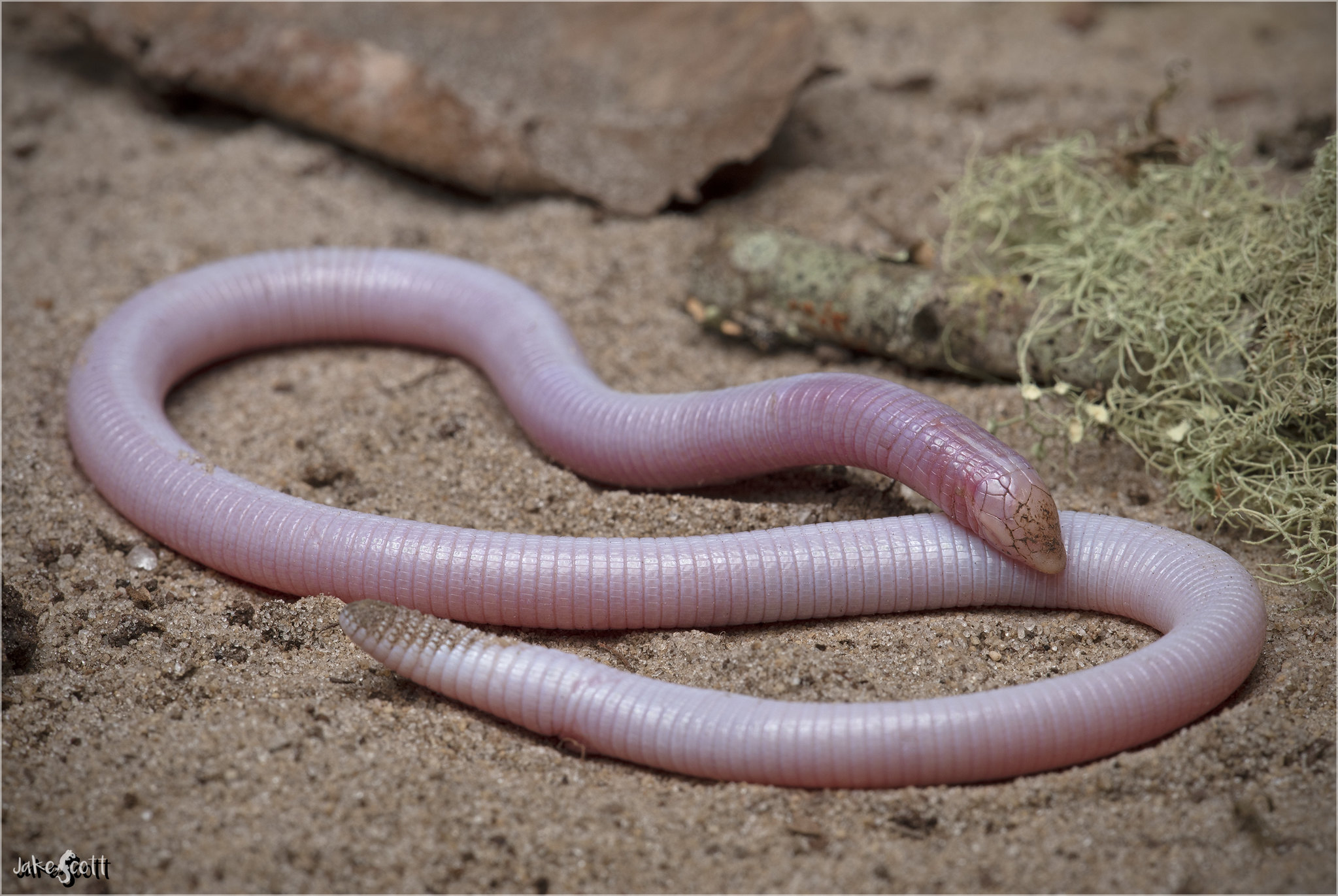
florida worm lizard habitats
hardwood hammocks, pine forests, suburb neighborhoods occasionally
florida worm lizard range
central/north-central peninsula, endemic (almost) to fl- 2 GA records
other florida worm lizard info
-TL ~10 in; completely fossorial, may come to surface after rains, may be found under deeply buried logs and deep leaf litter; feed on small inverts- earthworms, termites, beetle larvae; preds include shrikes and coral snakes; lay 1-3 tiny eggs; ecology is poorly known
eastern glass lizard identification
lacks a distinct middorsal stripe, no stripes below lateral groove, brownish green color with many whitish speckles esp on neck
-long and thin and legless and striped
-osteoderms beneath scales make body stiff
-pleat (groove) runs length of body
-look like snakes but have eyelids and external ear openings
-esp long tail, autotomy common

eastern glass lizard habitats
open grassy habitats- road shoulders, pine flatwoods, tropical hardwood hammocks, barrier islands
eastern glass lizard range
entire state of fl
other info about the eastern glass lizard
-SVL to ~10 in, TL to ~40 in; burrow in grasses and sandy soils; actively forage above ground during day; feed on insects, spiders, snails, small snakes, small lizards and their eggs; lay 4-15 eggs in late spring/early summer
general gecko information
-lack eyelids (most sp globally)
-dorsoventrally flattened
-many species have expanded toe tips with lamellae (not sphaerodactylids)
-many have a single claw on each toe
-primarily nocturnal
-1 native sp in fl, ~15 introduced sp est
florida reef gecko identification
tiny brown lizard, brown stripes on head, yellow spots on neck (F and juv) and often dark spots and speckles, rel large scales compared to introduced geckos, scales keeled, snout flat and pointed, round toe tips lacks a claw

florida reef gecko habitats
pine rocklands, tropical hardwood hammocks, vacant lots
fl reef gecko range
keys and very SE FL
other fl reef gecko info
-smallest native* (some consider it introduced) lizard in fl/us, TL ~2-2.5 in; nocturnal; common but secretive; feed on ants, tiny flies, other small insects; lay single eggs year round
characteristics of phyrnosomatidae- spiny lizards
-keeled, pointed scales
-blocky heads
-thin toes w claw
-diurnal
-males w bold blue belly/throat patches
-2 native sp in fl
eastern fence lizard identification
-strongly keeled scales tipped w spine, gray to brown, sexually dimorphic
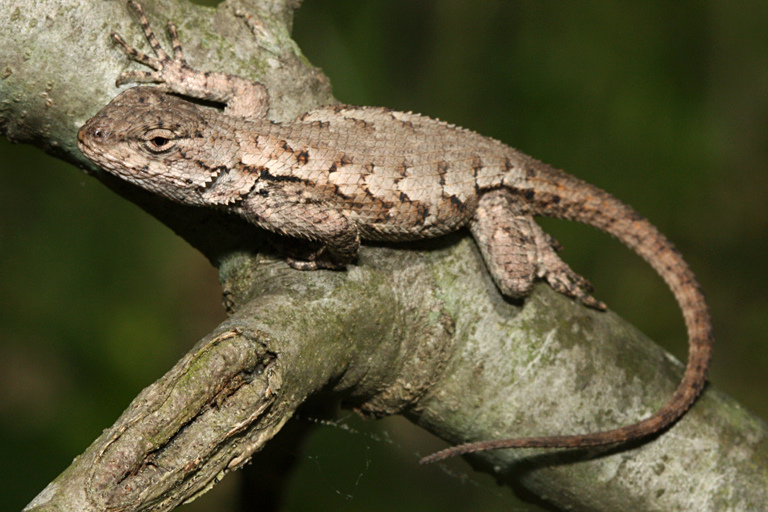
eastern fence lizard habitats
xeric uplands- sandhills and scrub; dry open woodlands
eastern fence lizard fl range
to the central peninsula
other info about eastern fence lizard
-TL to ~6 in; often seen on downed snags and tree trunks, may hear them scurry before you see them; adult males w bold blue belly/throat patches and enlarged post anal scales; bury clutch of 5-15 eggs in loose sand; feed on a diversity of small inverts, a “sit and wait” predator
fl scrub lizard identification
keeled scales tipped w spine, gray to brown color, broad brown lateral band, sexually dimorphic

fl scrub lizard habitats
xeric uplands- sandhills and scrub; coastal dunes
fl scrub lizard range
ENDEMIC peninsular fl only
other fl scrub lizard info
-TL to ~5 in; may be seen during day on ground around shrubs
-adult males w bold blue belly/throat patches, females w lighter blue and less extensive
-feed on ants, beetles, crickets, grasshoppers and spiders
-lay sev eggs in small hole dug in sand
-Fs lay up to 5 clutches a year in spring/summer
-hab loss is an issue
anolidae characteristics
-small, granular scales
-pronounced dewlap in males
-expanded toes w lamellae and claw
-ability to change color- not a true chameleon taxonomically speaking
-relatively large pointed head
-1 native sp in fl, 10+ introduced sp doc
green anole identification
green to brown color, long snout, expanded toe pads, white belly, small granular scales
green anole habitat and range
most habs with trees and shrubs, common in suburb areas; entire state
other green anole info
-TL to ~7 in
-excellent climbers and very arborial
-may be active all year
-ability to go from bright green to dark brown very fast- NOT a chameleon, change color in response to temp and mood; active foragers that stalk prey
-M w bright pink dewlap
-F w light stripe down back
-brown anoles are a threat
general skink info
-smooth scales in all native FL species
-shiny, glossy appearance
-osteoderms underneath scales
-all w 4 legs, but some reduced in size
-often striped
-pronounced caudal autotomy
-7 sp in fl, most sp-rich native lizard fam in fl and globally
fl sand skink identification
gray/white/tan, dark flecks, eye stripe, diminutive legs, wedge shaped head, no ear opening
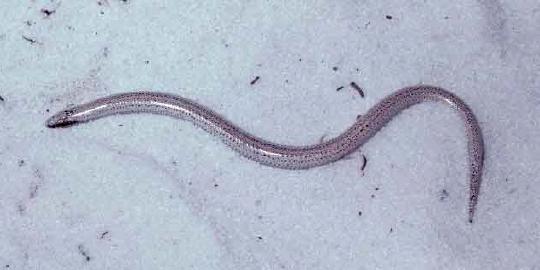
fl sand skink habs and range
scrub mainly sometimes in sandhills; endemic mid fl ridge of peninsular FL
other FL sand skink info
-TL to ~5 in
-fossorial sand swimmer, spend much of time several in to 2 ft deep, leave undulating trail when near surface
-closely related to mole skinks
-feed on termites, beetle larvae, other small insects
-may live 8-10 years, federally listed as threatened under the ESA
mole skink identification
brown to beige body, often light dorsolateral stripes, small legs, colored tails, conical head

mole skink habitats/range
xeric habs- sandhill, scrub, xeric hammock, beach dunes; most of state excluding everglades, also in keys
mole skink other info
-TL to ~5 in
-5 subsp in fl, varying tail colors- blue, red, orange, salmon, lavender; tail color often changes as skink ages
-fossorial in loose sand; may bask just under sand surface in pocket gopher mounds
-feed mainly on small arthropods
-scarlet kingsnakes are significant predator
little brown skink identification
brown back, dark dorsolateral stripes, creamy yellow belly, relatively long thin tail
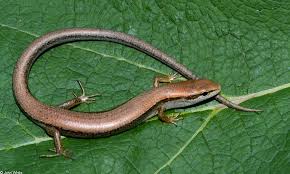
little brown skink habitats/range
sandhills, flatwoods, hammocks, suburb areas; entire state
other info about little brown skink
-TL to ~5 in
-terrestrial and rarely climbs; lives on forest floor in leaf litter
-moves with serpentine locomotion
-feed on small inverts- mainly arthropods
-lay 1-7 eggs apr-july, may nest communally- one such nest had 66 eggs
-one of our most common skinks
southeastern 5-lined skink identification
juveniles black w 5 thin light stripes and blue tail; F is brown, often retain stripes but tail often fades to brown; M may become solid brown w/out stripes, head becomes red when breeding; scales under tail uniform in width

southeastern 5-lined skink habitats/range
sandhills/pine savannahs and flatwoods mainly; entire state
other info about southeastern 5 lined skink
-TL to ~7 in
-may climb trunks of trees
-[refer areas of logs and debris
-can tolerate drier habs than the other 2 large striped sp
-actively forage by day in leaf litter
-CS= 4-11, brooded by F
broad-headed skink identification
similar to the SE 5-lines skink, Ms w very wide heads/jowls that are bright red/orange during breeding; wide row of scales under tail
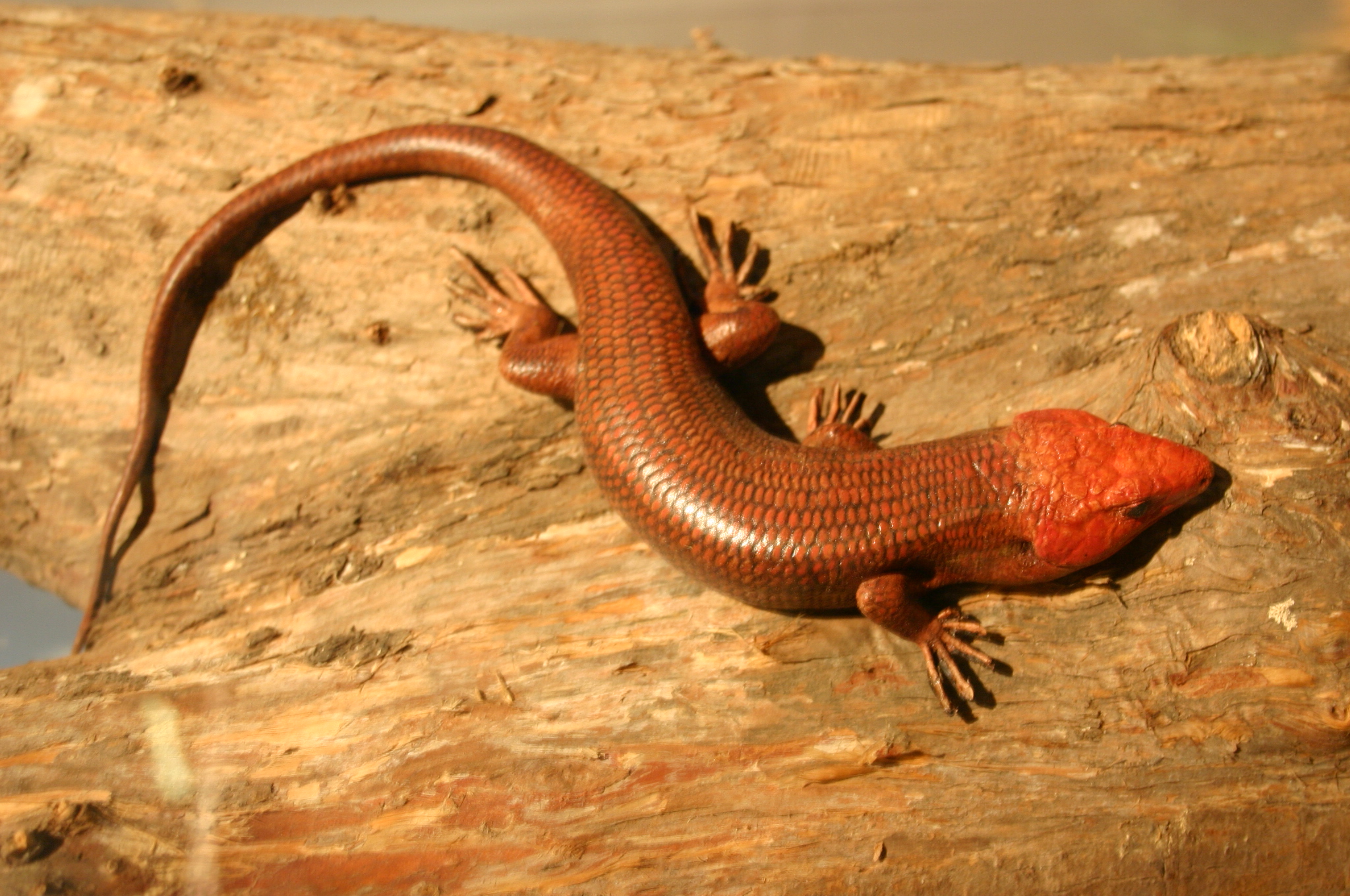
broad-headed skink habs and range
hardwood hammocks mainly, moist woodlands; C FL peninsula and panhandle
other info about broad-headed skink
-TL to ~12 in, largest native lizard
-strong lizard w painful bite
-prefer areas of large rotting logs and hollow trees for cover
-quite arboreal and may retreat up a tree
-actively forage usually on the ground
-CS= 6-16 eggs, female broods eggs
-Ms fight for Fs and territory
teiidae- whiptails characteristics
-thin bodied (introduced Tegu is stout)
-long, thin tail that will break
-thin white stripes on back
-tiny scales on back, granular
-rectangular scales on belly arranged in 8 parallel rows
-1 native sp in fl, sev introduced
six-lined racerunner identification
brown/black back w 6 conspicuous stripes that never fade; belly is white in Fs and juvys, bluish in Ms

six-lined racerunner habs/range
open, dry uplands mainly- scrub, dry flatwoods, sandhills, dunes; all state except everglades
other info about six-lined racerunner
-TL to ~9 in
-a very swift lizard that is hard to capture by hand- colloquially called “sand streak”
-actively forages for insects and spiders
-males may become dark blue during breeding
-F lays 2-8 eggs in loose soil
-rest in burrow when not out foraging, spend night in burrow or under cover
what are the 5 families of fl’s native snakes?
-viperidae: pit vipers (rattlesnakes (3), cottonmouth (2), copperhead)
-elapidae: coral snake (1)
-colubridae: “non-venomous” snakes
-dipsadidiae- egg-laying, rear fanged snakes
-natricidae- aquatic/semi-aquatic live bearers
colubridae - non-venomous snakes
-no native FL sp produces a venom that is medically sig to humans
-great variation in size, color, pattern
-previously the most speciose snake family in fl
-lay eggs
-head relatively narrow (not blocky) and not very distinct from the neck
—some will rapidly vibrate their tail- rats and racers
-found primarily in terrestrial habs
-~20 sp in fl
scarletsnake identification
small (1-1.5 ft usually); red pointed snout; bands of red-black-cream yellow; bands do not extend to belly
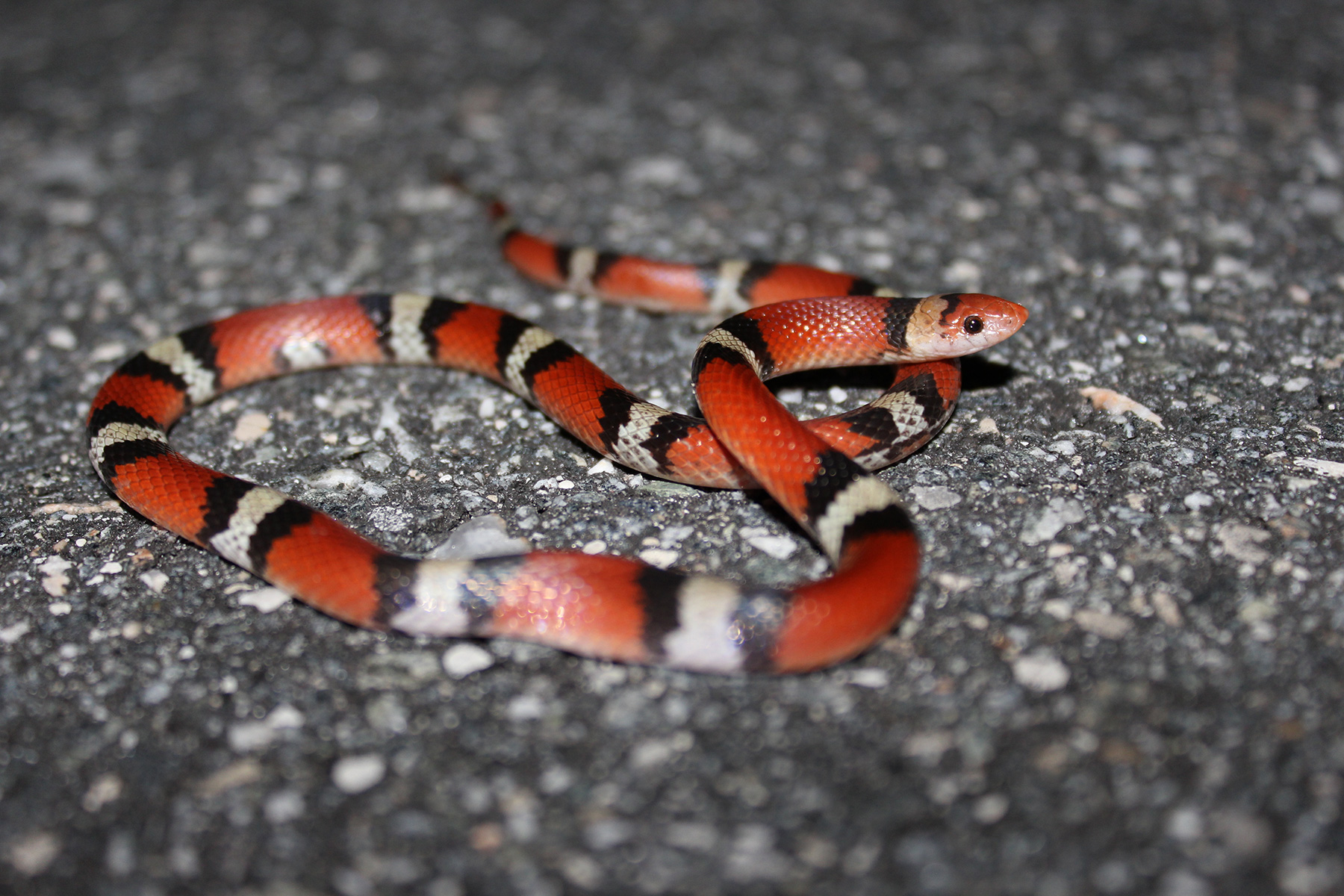
scarletsnake habitats/range
various uplands w sandy soils- pine flatwoods, sandhills, hardwood hammocks; full state
other info about scarletsnakes
-quite fossorial lifestyle
-feeds on small reptiles and their eggs, insects, slugs; has enlarged rear teeth for puncturing the eggs it eats
-lays its eggs in burrows or under logs/rocks
-CS avg 5 eggs
-predators include coral snakes, predatory birds and mammals, mimics coral snake
scarlet kingsnake identification
rounded red snout, alternating bands red-black-yellow bands ring entire body
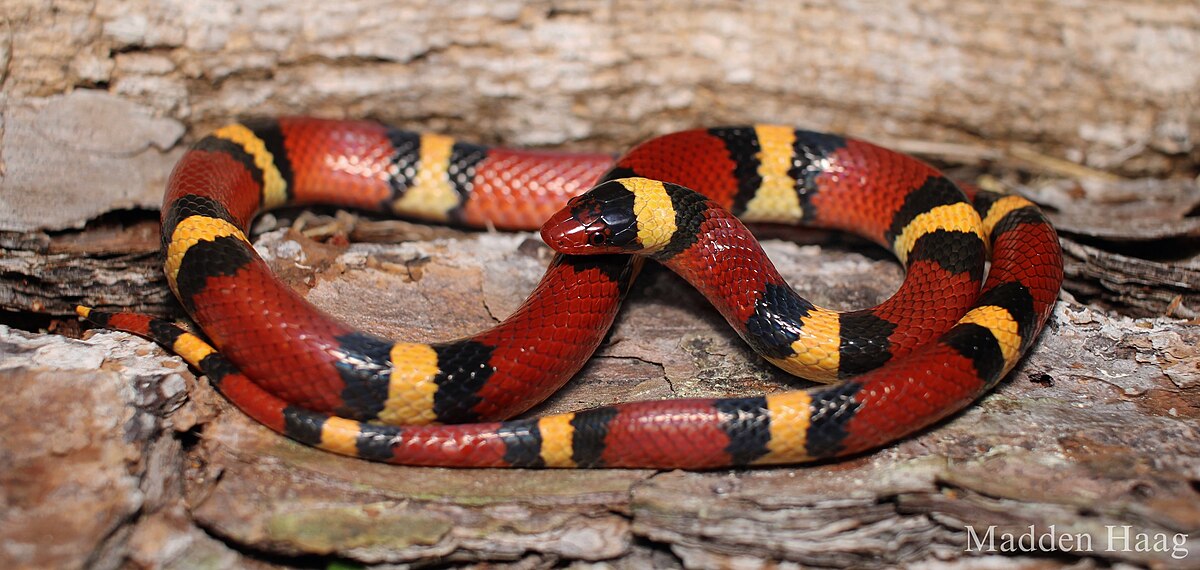
scarlet kingsnake habs/range
-various: sandhills, hardwood hammocks, ag areas, wooded lots, full state
other info about scarlet kingsnake
-TL ~1-1/5 ft (max 2 ft)
-feeds mainly on lizards, small snakes, reptile eggs
-CS= 4-5 eggs
-coral snake mimic
-highly sought after snake for pet trade
-often targeted by peeling park off pine snags
north american (black) racer identification
long and slender, smooth scales; adults solid black/dk gray, greenish/bluish gray in SFL, chin throat white/tan, dk gray belly; juveniles w dark blotches and flecks, belly w flecks
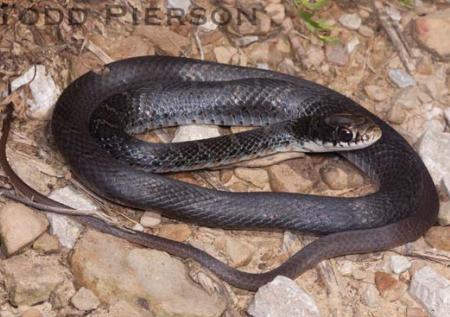
north american (black) racer habitats/range
-generalist found in just about any terrestrial hab, common in suburbia; all of fl
other info about north american black racer
-TL~2-4 ft (max 6 ft)
-lays 4-36 elongate eggs w rough surface
-eats insects, anurans, lizards, small mammals and birds- does not constrict prey
-commonly referred to as “black snake"; one of FL’s most often encountered snakes
-juveniles often misidentified as pygmy RS and killed; will vigorously shake tail when agitated
coachwhip identification
long and slender, large eye, scales pattern resembles braided bullwhip; adults w dark brown head fading to beige; juvys tan w numerous darker bands/band esp toward head

coachwhip habitats/range
variety of uplands-sandhill, flatwoods, scrub, coastal dunes; all state